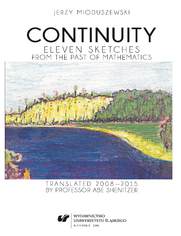Continuity. Eleven sketches from the past of Mathematics - Helion

ISBN: 978-8-3801-2950-4
stron: 200, Format: ebook
Data wydania: 2016-09-29
Księgarnia: Helion
Cena książki: 16,74 zł (poprzednio: 20,93 zł)
Oszczędzasz: 20% (-4,19 zł)
The book was written in the eighties of the last century. Being encouraged by the editorial board of monthly Delta in the person of Professor Marek Kordos, the author’s first aim was a collection of essays about Peano maps, lakes of Wada, and several singularities of real functions. But it was the time when university duties stopped and the author could freely meditate whether this curious mathematics had its roots in the forgotten past. He remembered old authors who began their books with the words “already the ancient Greeks… .”
The celebrated nineteenth century, the century of concepts, was preceded by the century of calculations. Going further back we can see Newton, but what and who was there before? Were the centuries between the Ancients and Newton a vacuum in mathematical sciences? Accidentally, the treatise De continuo by Thomas Bradwardine, the Archbishop of Canterbury, led the author into an unknown and strange world of medieval scholastic thought, showing to him the lost thread joining our times with Zeno, Aristotle and Democritus.
However, to find this forgotten link a step should be taken beyond pure mathematical thinking. In this extended surrounding we can observe the unity of mathematical concepts being non-existent in the realm of pure mathematics.
Osoby które kupowały "Continuity. Eleven sketches from the past of Mathematics", wybierały także:
- Ryszard Kilvington. Nieskończoność i geometria 19,52 zł, (8,98 zł -54%)
- Matematyka w deep learningu. Co musisz wiedzie 89,00 zł, (44,50 zł -50%)
- Matematyka w programowaniu gier i grafice komputerowej. Tworzenie i renderowanie wirtualnych 89,00 zł, (44,50 zł -50%)
- Podstawy matematyki w data science. Algebra liniowa, rachunek prawdopodobie 69,00 zł, (34,50 zł -50%)
- Domowe lekcje matematyki. Klasy 4-6 39,90 zł, (19,95 zł -50%)
Spis treści
Continuity. Eleven sketches from the past of Mathematics eBook -- spis treści
Table of contents
From the author / 7
Introduction / 9
Chapter I
The flying arrow • Aristotle’s view of the aporia of Zeno • Its influence on the evolution of geometry and on the science of motion • Democritus’s version of this aporia • On mathematical atomism / 15
Chapter II
Aporia of the wanderer • The Archimedean postulate • The Eudoxian exhaustion lemma • Non-Archimedean continua • Another Zeno’s difficulty: Stadium / 27
Chapter III
Number • On idealism in mathematics • Its two varieties: Pythagoreism and Platonism • Discovery of incommensurable segments • The Euclidean algorithm • On some possible meanings of the proportion of segments / 35
Chapter IV
On geometric magnitudes • Comparison of polygons from the point of view of area • Comparison through complementation • Comparison through finite decomposition • The role of Archimedean postulate • On quadratures / 51
Chapter V
The Eudoxian theory of proportions • The role in it of the Archimedean postulate • The theorem on interchanging terms in a proportion • On Tales’s theorem • Comparison with Dedekind theory • Inequality of proportions • On the area of a circle • On Greek geometric algebra • The Elements as an attempt to geometrize arithmetic / 63
Chapter VI
The Arab Middle Ages • Euclid’s parallel postulate: mistakes and progress • Singular features of the philosophy of nature of the Arab East / 81
Chapter VII
The European Middle Ages • Disputes about the structure of the continuum • Oresme and the Calculators on the intensity of changes • The 1 : 3 : 5 : 7 : … sequence • The theory of impetus • Quies media • The ballistics of Albert of Saxony and of Tartaglia • Galileo • Supplements / 95
Chapter VIII
The method of indivisibles • Three ways of computing the area of a circle • Kepler: the principle of fields and a barrel • The Cavalieri’s principle • The Roberval cycloid • Need we explain it by undivisibles? • Towards magic thinking • Descartes / 123
Chapter IX
Calculus • Derivative of xn • Barrow’s observation as motivation for this computation • The role of the Calculators • The impetum theory as motivation • Philosophiae Naturalis Principia Mathematica and the theory of fluxions • Leibniz • Voltaire on Newton • Hypotheses non fingo? / 141
Chapter X
Euler • A century of computations and undisturbed progress • Discussion on the term of arbitrary function • The number e • Infinitesimals and infinities • Lagrange’s objection • Barriers of growth / 167
Chapter XI
A debt redeemed • The beginning of the new analysis: Cauchy and Bolzano • Weierstrass • The arithmetization of analysis • Cantor • The role of Dedekind • Set theory did not come into being accidentally • Nothing is ever completely settled / 177
Epilogue / 189
Author’s reminiscences / 195





